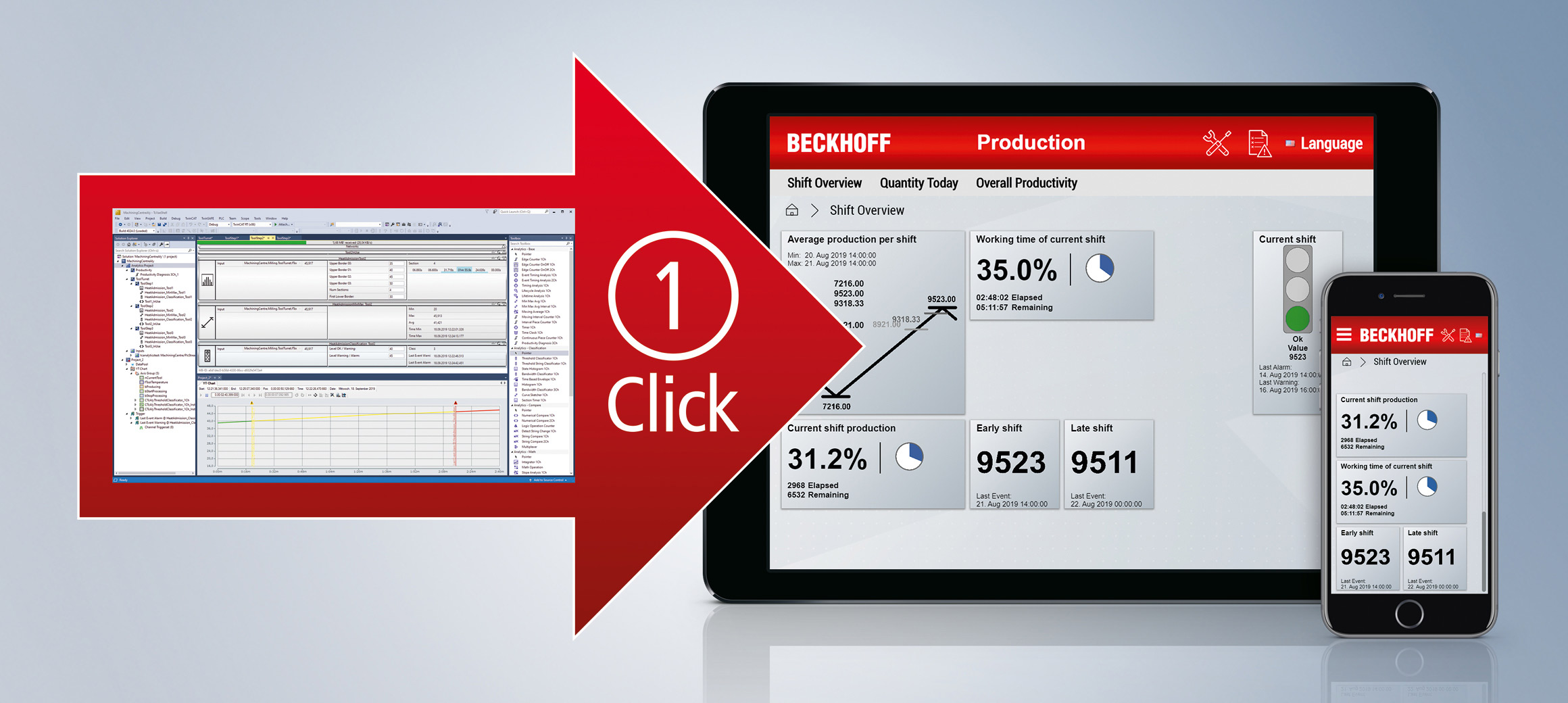

The One-Click Dashboard from TwinCAT Analytics is one of the latest developments that saves a lot of valuable engineering time
When calculating the costs of a machine or plant, the engineering part is often overlooked or underestimated. Moreover, in some cases, the engineering costs are very high and include more than the initial development costs. They may cover the costs for commissioning and maintenance – including troubleshooting and further development – over the entire service life of the machine or system. Here TwinCAT software represents an ideal solution with its integration in Visual Studio® and many additional functions.
Microsoft Visual Studio® is an established development environment used to create and maintain software applications on a global scale. The automation engineer can also leverage this platform with TwinCAT. Maintenance includes versioning software using source code management tools – such as Microsoft Team Foundation Server, SVN, or Git – that can be easily accessed using the built-in interfaces of Visual Studio®.
Use established IT procedures
Agile software development is the method of choice in IT: responding quickly and flexibly while maintaining high software quality. That is exactly what is needed in the automation environment. So why not use the same methods and toolboxes? Through the integration of TwinCAT in Visual Studio® this is easily possible. Toolboxes for Continuous Integration and Continuous Deployment have interfaces to Visual Studio® and therefore automatically interface with TwinCAT. The TwinCAT Automation Interface supports all processes automatically, without manual intervention. C++ or C# are the standard IT programming languages and are object-oriented, of course. With the third edition of IEC 61131-3, PLC programmers can use all the possibilities of object orientation. If needed, it is possible to mix "normal" code and object-oriented code using all five available programming languages.
The more extensive the software, the more difficult it is to keep track of. Here, the Unified Modeling Language (UML) can help. With the UML class diagram – known from IT programming languages – it is very easy to graphically represent all interdependencies of the classes. In addition, TwinCAT UML offers the option to use a simple graphical programming language for the sequence control of a machine via the state diagram. The advantage of UML is that this type of representation and state programming is well known and popular in IT.
Not only is the amount of software in machines growing, but also the process speed of these machines. As a result, it is increasingly important to be able to optimize the processing times in the PLC while the plant is running. This is very easy to do with the new TwinCAT Profiler. Well prepared, the programmer can quickly see at which points in the process time is consumed and optimize it accordingly. The profiler is based on another new tool for monitoring and optimizing real-time applications. Even with many tasks running on many processor cores of an IPC, the TwinCAT Realtime Monitor provides a simple graphical overview of the time sequences and dependencies. This means bottlenecks can be more easily identified and remedied. By placing markers in the sequence, developers can also monitor the process of a machine. Problems in the process – such as unnecessary waiting times – can be detected and eliminated.
Control cabinet design and HMI
Along with software development, it is also critical to consider control cabinet design with the overall automation technology. In order to increase engineering efficiency, TwinCAT offers an interface for the standardized exchange format AutomationML. With this TwinCAT XCAD interface, topology data from ECAD systems can be transferred to TwinCAT and, if necessary, additional PLC content can be generated automatically.
A human machine interface (HMI) is also almost always part of the machine software in automation technology. Its creation should be closely connected with the PLC development. For this purpose, TwinCAT HMI offers an advanced architecture with HTML5 and JavaScript as well as an engineering interface in Visual Studio®. Here the user does not need to have any knowledge of HTML and JavaScript. A what-you-see-is-what-you-get (WYSIWYG) editor instantly shows the resulting visualization in the browser. This makes it very easy to get started.
Convenient diagnostics – even during operation
Diagnostic tools are important when the machine is being programmed or even when it is already in operation at the end customer’s facilities. When a machine is in operation, it may be necessary to record analog or digital values and display them graphically, which is easy with TwinCAT Scope and its various display formats and options to export data to Excel files, among other things. If a large number of machines need to be analyzed and optimized worldwide, TwinCAT Analytics can be used. The collection, storage and analysis of data are completely integrated. With TwinCAT HMI and the One-Click Dashboard (pictured) from TwinCAT Analytics, the results can be displayed quickly and without any programming effort. And all this is also possible in the cloud. With TwinCAT Cloud Engineering, all engineering tools can be used in a virtual machine in the cloud. The advantage for the programmer is no complex installation of tools on the laptop; an Internet browser is sufficient.